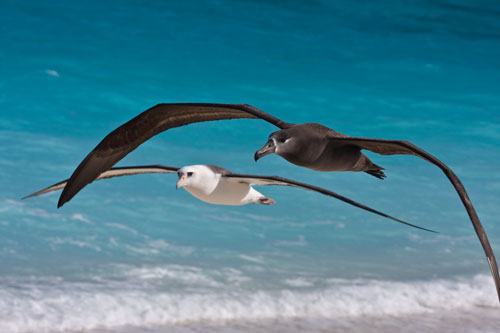The USA's Hawaiian Islands in the North Pacific support breeding populations of three ACAP-listed seabirds, all albatrosses of the genus Phoebastria. Two of these species, the Black-footed P. nigripes and the Laysan P. immutabilis, have by far the larger part of their populations breeding within the Hawaiian island chain. In contrast, only two pairs of Short-tailed P. albatrus albatrosses currently breed within the region, and one of them, on Kure Atoll, is a female-female pair that lays infertile eggs. The second pair, on Midway Atoll, is currently rearing its second chick.
There are a number of other seabirds that breed within the islands, including a further eight species of the order Procellariiformes. This group includes three species of Puffinus shearwaters: Wedge-tailed P. pacificus, Christmas P. nativitatus and Newell's P. newelli. The last is endemic to the Hawaiian high islands and has a globally threatened status of Endangered due to the several threats it faces and its decreasing population (click here).
Robert Shallenberger's book on Hawaiian seabirds considers all these species, along with tropic birds, frigate birds and boobies (six species) and terns (six species, including noddies). The book is built around its photographs, all good, some excellent, most of them taken by the author, who earned his PhD studying Hawaiian seabirds (see www.shallenbergerphoto.com) and subsequently spent three years on Midway as a refuge manager.

A Black-footed and a Laysan Albatross fly in formation
Photograph by Eric Vanderwerf
Each species is illustrated by two to seven colour photos, some full page, in this landscape-orientated book. I imagine some of the pictures were a tad sharper in the original, but the colour rendition looks good to my eye. Sticking to the albatrosses, I liked the photos of displaying birds, with Black-foots on tiptoe, and especially the adult Short-tail displaying to the remarkably lifelike decoys on Midway's Eastern Island - where breeding is now occurring (click here). Among the non-procellariiform seabirds I liked the photos of the albeit photogenic White or Fairy Terns Gygis alba with their eggs and chicks balancing on narrow branches.
The accompanying text for each species is brief but informative, and from my limited southern hemisphere perspective, seems authoritative. Following the 23 species accounts, which make up 70 pages of this 120-page soft-cover book, there are short chapters entitled The Cultural Connection, Conservation Changes, Observing Hawai'i's Seabirds and Photographic Tips, followed by a useful table of the 23 species that includes their Hawaiian names and a short list of 11 books for further reading and consultation.
"Rob's Rules for Colony Visitors" in the penultimate chapter is worthy of repeating here in its entirety:
Rule One: Avoid frightening birds from their nests as eggs and small chicks quickly overheat in the sun.
Rule Two: Watch your step. Better yet, stay on the periphery of the colony.
Rule Three. Wear a hat.
Rule Four: Don't look up.
Rule Five: If you ignore Rule Four, keep your mouth closed.
As a veteran of the tern and gull colonies of South Africa's guano islands, I fully support these five simple rules!
Rob Shallenberger's book will make a good souvenir of visits to Hawaii's seabird colonies and is to be recommended as a pleasant companion to a field guide on a study shelf.
Shallenberger, R.J. 2010. Hawaiian Birds of the Sea Nā Manu Kai. Honolulu: University of Hawai'i Press. 120 pp. ISBN 978-0-8248-3403-6. USD 21.99. www.uhpress.hawaii.edu.
John Cooper, ACAP Information Officer, 18 February 2012

 Français
Français  English
English  Español
Español